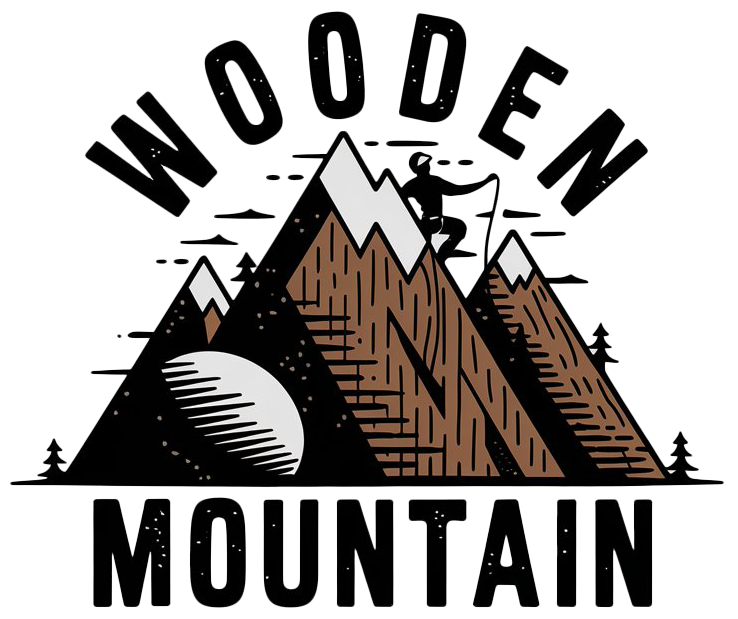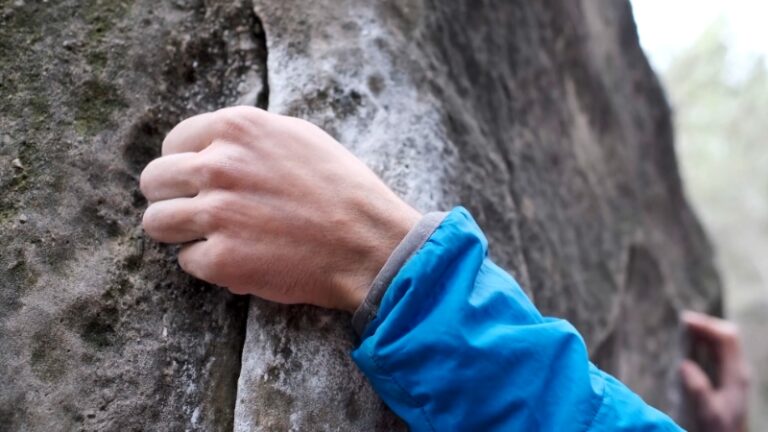Many climbers ask where to start. The best beginner bouldering spots in the USA that climbers can visit are spread across various terrains and climates.
Some parks offer soft landings, clear approach trails, and short routes with stable holds.
New climbers need places where the pressure is low and the fun is high. Let’s discuss clear options for anyone looking to try outdoor bouldering for the first time.
Why Outdoor Bouldering for Beginners Feels Different
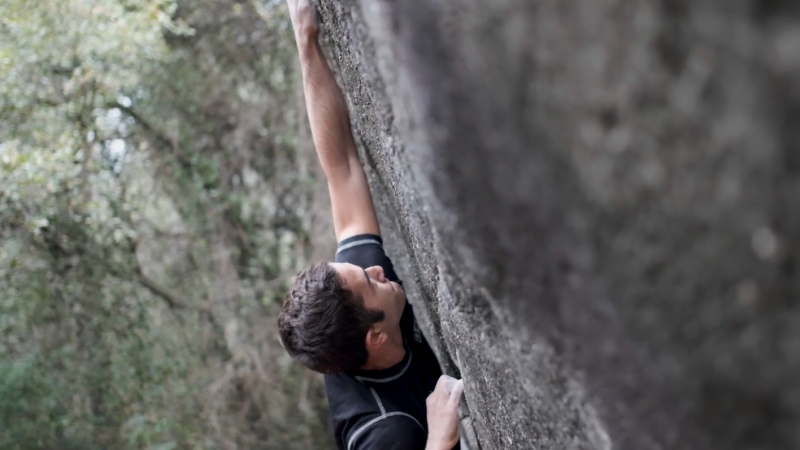
Outdoor bouldering for beginners gives a unique sense of freedom. Nature shapes every route, and each grip feels earned. Indoors feels cleaner, but rock textures outdoors tell a different story.
The friction varies, the lighting changes, and the air feels more alive. Beginners learn faster by facing those natural conditions early on.
The mental shift also matters. Outside, there is no grading chart on the wall. Climbers learn to trust their instincts rather than rely on preset color codes.
The experience builds confidence through problem-solving and exploration. Environmental awareness also sharpens, as each move must adjust to wind, sun, and surface conditions.
What Makes a Spot Beginner-Friendly
Easy bouldering routes in USA parks depend on a few key factors. Trails must be short and safe. Rocks should be solid with obvious holds. Landing zones should allow safe falls. A quiet area with soft mats or flat dirt makes first sessions less stressful.
Good beginner spots also avoid routes with sharp rock or overhangs. Overhung problems often require strong shoulders and core tension, which most beginners do not yet control well.
A beginner-friendly area should also include plenty of routes within the V0 to V2 range, spread across multiple boulders. That way, new climbers can transition between problems without overexerting one part of their body.
Clear signage or easy-to-read guidebooks help too. If a new climber cannot find the route or exits the zone while lost, confidence drops. Accessibility matters beyond terrain.
Cell signal, nearby water sources, and available parking also affect the quality of the day.
Key Features for a Beginner Bouldering Spot
Feature
Description
Approach
Less than 15 minutes on foot
Route Height
Under 15 feet
Fall Zone
Flat ground or natural padding
Hold Type
Large, positive holds
Traffic Level
Low to moderate
1. Joshua Tree National Park, California — Sunny and Grippy
Joshua Tree remains one of the best U.S. bouldering areas for new climbers. It offers warm weather for most of the year, along with plenty of slab and jug-heavy problems under 10 feet.
The granite holds grip well in dry air. Many zones, such as Hidden Valley, have short walks from the car and allow beginners to climb close to ground level. Locals recommend starting with problems at Cap Rock or the Short Wall area.
The open desert setting improves visibility, so foot placements feel easier to read in full sunlight. Parking is available near most trails, and access to restrooms adds to the comfort.
Rock texture changes from one formation to another, which teaches beginners how to adjust grip pressure.
2. Hueco Tanks, Texas — History Meets Technique
Hueco Tanks hold a key place in American bouldering history. First-time bouldering outdoors feels exciting here due to the unique shapes carved into the volcanic rock. Beginner climbing destinations must keep the challenge fair, and Hueco does that with V0 to V2 circuits across North Mountain.
Permits are needed, but guides help make the first trip smoother. Hueco combines access, history, and real technique training.
The dry climate allows year-round visits, and the desert wind keeps hands dry. Park staff maintain maps and check-ins to improve safety. Group tours for new climbers focus on body control and hand placement, requiring minimal strength.
3. Horse Pens 40, Alabama — Soft Landings and Friendly Grades
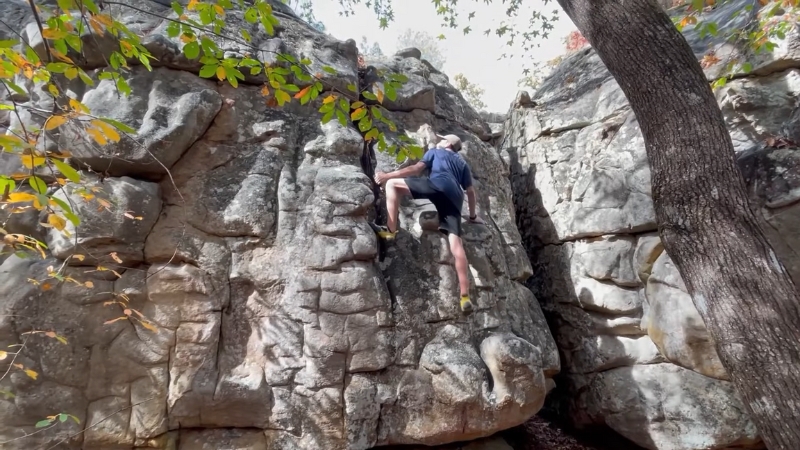
Horse Pens 40 delivers one of the best climbing parks in America for beginners due to its dense clusters of lowball boulders. The sandstone feels forgiving, and most landings fall onto soft pine needles or sand.
Routes often sit near camping areas, and grades range gently from V0 to V3. Locals suggest trying problems near Spirit Rock for mellow climbs and low risk. It works well for those wanting to spend whole weekends on easy climbs.
On-site camping makes it easy to take extended breaks or return to problems after rest. The southern hospitality at the park office sets a welcoming tone for new visitors, with clear trail markers and visible chalk paths that help reduce confusion.
4. Mount Gretna, Pennsylvania — Shaded and Gentle
Mount Gretna stands out among bouldering locations on the East Coast, offering easy access. It provides short boulders surrounded by forest and moss. Most problems can be solved with fewer than five moves.
Holds appear smooth due to sandstone erosion, but the style feels technical and safe for new climbers. Routes like Orange Wall or Buttermilk warmups draw many first-timers each season.
Shade keeps temperatures mild, even in the midsummer heat. Local climbers often leave route notes on trail signs, which makes solo visits less confusing. A nearby lake adds a cooling break between sessions.
5. Flagstaff, Arizona — Cool Altitude and Calm Vibes
View this post on Instagram
Flagstaff belongs in every bouldering travel guide that USA beginners look for. The volcanic dacite feels sharp, but holds are stable and clean. Most climbing areas are situated under tall pine trees, so the air remains cool.
Priest Draw is a top pick due to its short approach and shaded landings. Easy bouldering routes in the USA lists often include Northern Arizona due to its mix of access and dry weather.
Flagstaff sits above 7000 feet, so climbers often find relief from the heat that plagues lower zones. Trailheads start close to paved roads, which cuts down on effort. Snow can close some trails in winter, but summer and fall offer calm conditions.
6. Lizard’s Mouth, California — Ocean Breeze and Simple Movement
Lizard’s Mouth is situated above Santa Barbara and offers stunning coastal views with gentle climbs. Most routes are low to the ground with natural crash zones made of sand or soft rock.
New climbers love the scenery, but the actual draw lies in how calm the movement feels. Easy traverses and wide holds allow people to focus on their footwork. Parking is limited, but the short hike gives a full view of the Pacific.
Humidity can slightly affect grip, but mild temperatures help keep hands flexible. Sunsets from the bluff offer a mental break after sessions. Groups often gather near the trailhead to share snacks and discuss route ideas.
7. The Kraft Boulders, Nevada — Beginner Goldmine near Las Vegas

The Kraft Boulders offer top bouldering spots for new climbers, located near an urban area. Located in Red Rock Canyon, it features sandstone blocks with clear chalk lines and obvious beta.
V0 routes like Potato Chips get climbed daily by new visitors. Sun exposure can be intense, so early starts are beneficial. Vegas locals often take friends there for their first outdoor send.
The zone is situated just 30 minutes from downtown Las Vegas, allowing for quick day trips. Crash pad rentals are available in local shops. Frequent foot traffic also improves trail conditions and wayfinding.
8. Rumney, New Hampshire — East Coast Entry Point
Rumney has earned respect for sport climbing, but it also has simple boulders scattered throughout the lower trails. Best beginner bouldering spots in the USA lists often include Rumney due to soft granite blocks and clear approach paths.
The woods stay cool even in summer, and each area feels quiet. Many problems are located near the parking area, so gear hauls often feel short. Local guides maintain quality info for new climbers year-round.
Fall colors add a scenic bonus in the month of October. Many problems offer cracks and slabs that reward balance over strength. Trail cleanup projects run often, which keeps the park in good shape.
9. Moe’s Valley, Utah — Sandstone Playground for First Steps
@holdsmallthings Missing St. George. This is “the swan” from Moes valley. #climb #😁😁😁 #bouldering ♬ I Think You Were in My Profile Picture Once – Modern Baseball
Moe’s Valley offers clean boulders near St. George. Its compact trail system and low crux height make it one of the most scenic bouldering areas the USA has for early practice. The sandstone breaks cleanly, and the landings rarely feel rough.
Many boulders cluster together, so people climb and rest in rotation. Locals say it teaches smart movement in a relaxed setting early on.
The desert backdrop adds stillness that helps calm nerves. Daylight lasts long during fall, which adds more climbing time. Nearby stores offer snacks and gear within a ten-minute walk from the trailhead.
Weather Guide for Key Beginner Areas
Location
Best Season
Temperature Range
Joshua Tree, CA
Winter to Spring
55 to 75 Fahrenheit
Hueco Tanks, TX
Winter
50 to 65 Fahrenheit
Horse Pens 40, AL
Fall to Spring
60 to 75 Fahrenheit
Flagstaff, AZ
Summer to Fall
65 to 80 Fahrenheit
Moe’s Valley, UT
Fall
60 to 70 Fahrenheit
Key Tips for First-Time Bouldering Outdoors
First-time bouldering outdoors can be new and challenging at first. Bring extra water and a second crash pad. Know how to spot safely.
Climb with a partner or a local who knows the area. Rest more often than in a gym.
Set goals before reaching the site. Do not plan too many climbs in one day. Keep your sessions short and your landings padded. Use sunscreen and stay aware of shifting light and rock temperature.
Step-by-Step Guide for a Safe First Day Outdoors
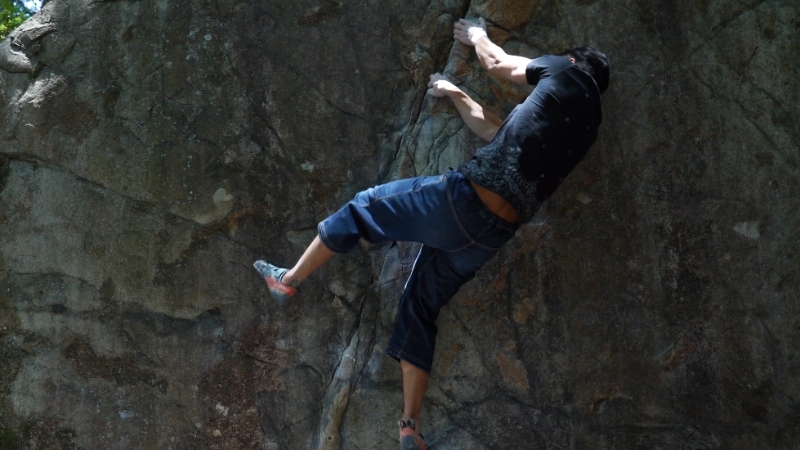
Pick a low-traffic spot listed in this guide. Check the weather and bring layers. Carry chalk, tape, a pad, and a printed map. Warm up by walking and stretching arms and ankles. Try a few V0s before progressing to higher levels.
Test each hold gently before loading your full weight. Watch how locals move to understand flow and rhythm. Take a long break between each problem. End with an easy send to leave feeling strong.
Why Terrain Matters More Than Grade
Grades vary across regions. A V1 in Texas does not feel like a V1 in California. Good terrain allows beginners to focus on balance, body tension, and hold reading.
Scenic bouldering areas that USA climbers love often provide broad flat zones that boost confidence. Prioritize feel and texture over number.
Terrain creates the mood of a climb. Smooth slabs teach balance while rough ledges teach grip control. Beginners learn more effectively when surface features align with their current skills. Easy bouldering routes in US parks often owe more to terrain than to the grade label.
How to Turn a Weekend Trip into Progress
Climbing trips for beginners work best with a goal. Pick three problems to work on over two days. Focus on movement, not completion. Bring a journal or take a video to review later—discuss beta and safety habits with locals.
Sleep well between days to stay sharp. Mix easier climbs into your second day. Reflect on progress each night. Celebrate small wins, such as improved footwork or reaching new holds.
Stories from First Climbs
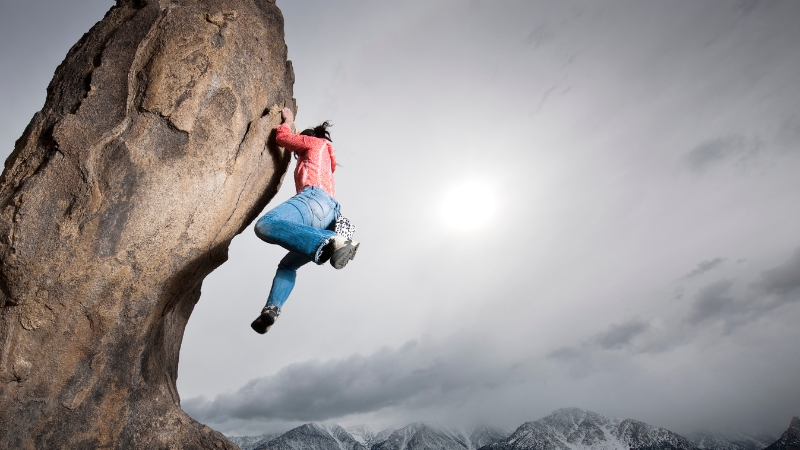
Emily from Salt Lake tried her first outdoor climb at Moe’s Valley. She failed three V0s in one day, but felt proud that she tried them alone. A month later, she returned with friends and climbed seven problems in a weekend.
Will from Boston started in Rumney and now helps beginners find warmup spots. Each visit instilled skills and confidence that lasted a lifetime.
Shawn, a high school student from Arizona, climbed in Priest Draw with his brother last summer. He had never touched real rock before. That day, he topped out on a V0 slab and called his dad from the car. Now he saves for pads with his part-time job and plans trips monthly.
Your First Climb Starts with the Right Spot
The best beginner bouldering spots USA climbers can trust offer more than easy grades. They provide low fear, good terrain, and memorable views.
Select a location that suits your season, your strength, and your preferred pace. Bring curiosity, rest often, and enjoy learning something new with each grip.
